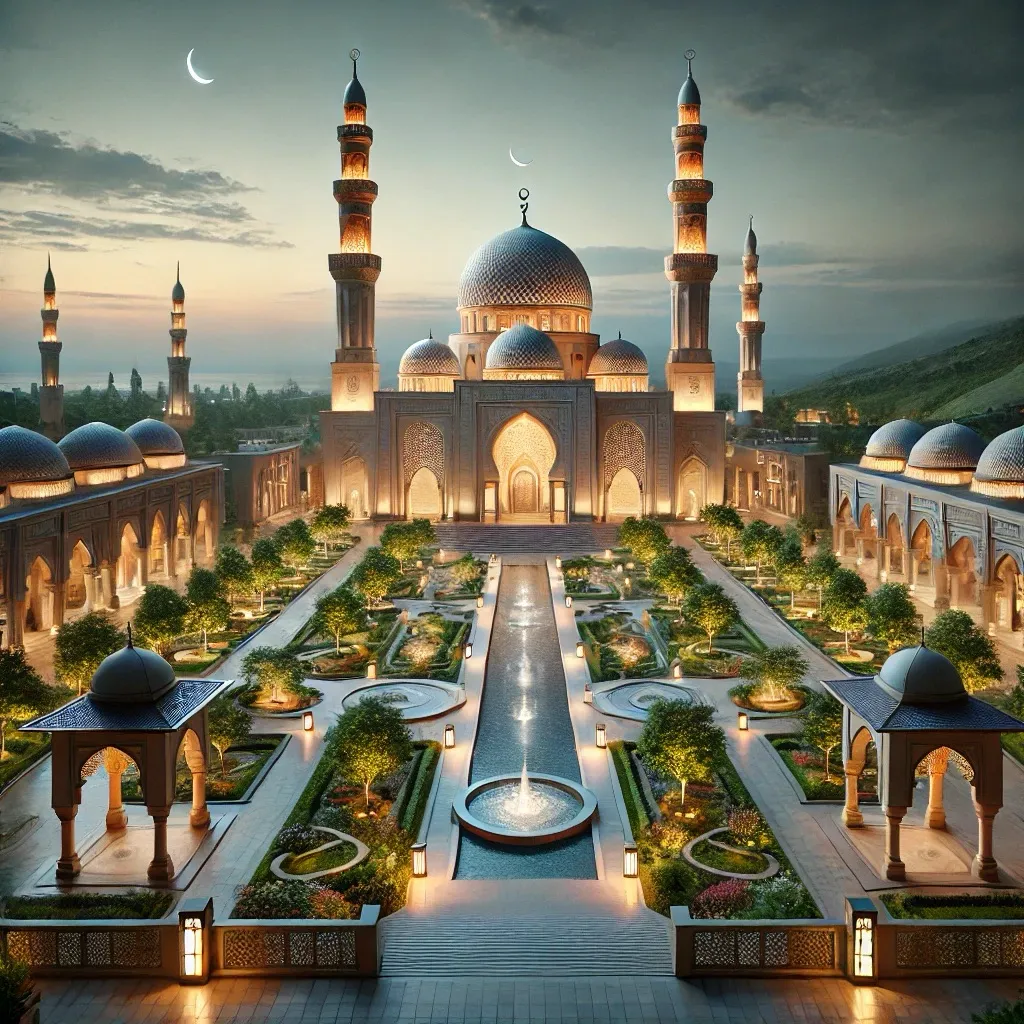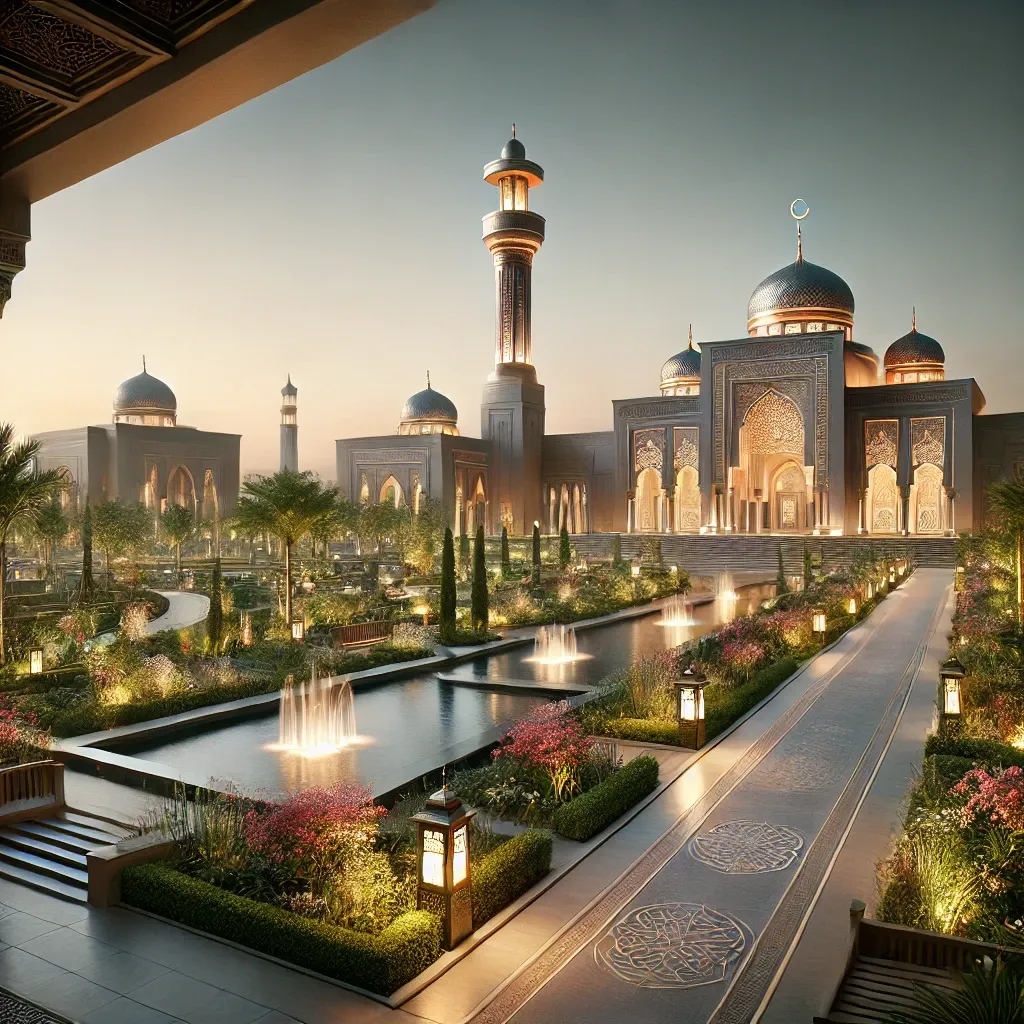AHNAKOT
Islamic History Park
Islamic history is rich with cultural, scientific, and religious achievements that have profoundly shaped the world. An Islamic History Park would serve as a place to celebrate this legacy, providing education and reflection on the contributions of Islamic civilization. Here’s a conceptual overview of what such a park could include:
AHNAKOT Islamic History Park
1. Origins of Islam
- Early Islamic History: The park could feature exhibits on the life of the Prophet Muhammad, the revelation of the Quran, and the early expansion of Islam in the 7th century. Key events like the Hijra (migration to Medina) and the establishment of the first Islamic community could be represented through detailed dioramas and interactive displays.
2. The Golden Age of Islam
- Scientific and Cultural Achievements: This section would highlight the period known as the Islamic Golden Age (8th to 14th centuries), during which scholars in the Islamic world made significant advances in fields like mathematics, astronomy, medicine, and philosophy. Exhibits could include models of ancient observatories, libraries, and universities, as well as the works of scholars like Al-Khwarizmi (the father of algebra), Ibn Sina (Avicenna), and Al-Razi (Rhazes).
3. Islamic Art and Architecture
- Architectural Wonders: The park could showcase the architectural marvels of the Islamic world, such as the Alhambra in Spain, the Great Mosque of Cordoba, the Dome of the Rock in Jerusalem, and the Taj Mahal in India. Visitors could explore replicas or scaled-down versions of these structures, learning about their historical and cultural significance.
- Islamic Calligraphy and Art: Islamic art, known for its intricate geometric patterns and calligraphy, would be displayed throughout the park. Visitors could engage in workshops to learn about and create their own pieces of Islamic art.
4. The Spread of Islam
- Global Influence: This section could trace the spread of Islam across different regions, from the Middle East to North Africa, Europe, Asia, and beyond. Exhibits could include maps, artifacts, and stories from Islamic communities around the world, emphasizing the diversity within the Islamic faith.
5. Islamic Contributions to World Civilization
- Cultural Exchange: The park could highlight the ways in which Islamic civilization interacted with other cultures, contributing to the Renaissance in Europe and the development of global trade networks. Exhibits could feature the Silk Road, the translation of Greek texts into Arabic, and the influence of Islamic philosophy on Western thought.
6. Contemporary Islamic World
- Modern Achievements: The park could also include sections dedicated to the modern Islamic world, showcasing the contributions of contemporary Muslim scientists, artists, and thinkers. It could provide a space for dialogue on the challenges and opportunities facing the global Muslim community today.
Park Features
- Prayer Areas: Designated areas for visitors to perform prayers, respecting the religious practices of Muslims.
- Gardens and Reflective Spaces: Tranquil gardens with fountains, pathways, and seating areas for meditation and reflection.
- Educational Centers: Facilities for lectures, workshops, and educational programs focused on Islamic history and culture.
- Exhibition Halls: Rotating exhibits on various aspects of Islamic civilization, from ancient manuscripts to modern innovations.
Cultural and Religious Events
- Islamic Festivals: The park could host celebrations of major Islamic festivals such as Eid al- Fitr and Eid al-Adha, offering visitors the chance to experience these important cultural events.
- Cultural Performances: Traditional music, dance, and storytelling performances that showcase the rich cultural heritage of the Islamic world.
Project Portal Link
-
PROJECT SECTOR 1
- 1.Affordable Housing District
- 2.African Harbor District
- 3.Agricultural and Food Production District
- 4.Agriculture and Livestock District
- 5.AIRPORT
- 6.Arabic Harbor District
- 7. AREYATHOR KHMER District
- 8.Buddhism Park History
- 9.Cambodian Historical and Cultural Museum
- 10.CENTRAL BUSINESS DISTRICT (CBD)
- 11.Christian Park History
- 12.City-Wide Integration and Features
- 13.Cultural and Arts District
- 14.Digital and Communications District
- 15.Education and Knowledge District
- 16.Entertainment and Media District
- 17.Environmental Education and Awareness District
-
PROJECT SECTOR 2
- 18.Environmental Research and Development District
- 19.Environmental Conservation District
- 20.Financial District
- 21.French Harbor District
- 22.Government and Administrative District
- 23.Greek Harbor District
- 24.Green Energy and Sustainability District
- 25.Health and Wellness District
- 26.HINDUISM PARK HISTORY
- 27.Historical and Heritage District
- 28.Innovation and Research District
- 29.Islamic History Park
- 31.Japanese Harbor District
- 32.Judaism Park History
- 33.Khmer Harbor District
- 34.Lake Tower District
- 35.Luxury Residential District
-
PROJECT SECTOR 3
- 36.MARINA DISTRICT
- 37.Mexican Harbor District
- 38.Museum Of The Future
- 39.Portuguese Harbor District
- 40.Public Services and Infrastructure District
- 41.Residential Districts
- 42.Retail and Commerce District
- 43.Smart Industrial and Manufacturing District
- 44.Smart Mobility and Transportation District
- 45.Smart Technology and AI District
- 46.Sports and Recreation District
- 47.Tech and Innovation District
- 48.Tourism and Hospitality District
- 49.Transport and Logistics District
- 50.Urban Agriculture and Food Security District V
- 51.Urban Design and Architecture District
- 52.Waterfront District
Project Portal Link
-
PROJECT SECTOR 1
- 1.Affordable Housing District
- 2.African Harbor District
- 3.Agricultural and Food Production District
- 4.Agriculture and Livestock District
- 5.AIRPORT
- 6.Arabic Harbor District
- 7. AREYATHOR KHMER District
- 8.Buddhism Park History
- 9.Cambodian Historical and Cultural Museum
- 10.CENTRAL BUSINESS DISTRICT (CBD)
- 11.Christian Park History
- 12.City-Wide Integration and Features
- 13.Cultural and Arts District
- 14.Digital and Communications District
- 15.Education and Knowledge District
- 16.Entertainment and Media District
- 17.Environmental Education and Awareness District
-
PROJECT SECTOR 2
- 18.Environmental Research and Development District
- 19.Environmental Conservation District
- 20.Financial District
- 21.French Harbor District
- 22.Government and Administrative District
- 23.Greek Harbor District
- 24.Green Energy and Sustainability District
- 25.Health and Wellness District
- 26.HINDUISM PARK HISTORY
- 27.Historical and Heritage District
- 28.Innovation and Research District
- 29.Islamic History Park
- 31.Japanese Harbor District
- 32.Judaism Park History
- 33.Khmer Harbor District
- 34.Lake Tower District
- 35.Luxury Residential District
-
PROJECT SECTOR 3
- 36.MARINA DISTRICT
- 37.Mexican Harbor District
- 38.Museum Of The Future
- 39.Portuguese Harbor District
- 40.Public Services and Infrastructure District
- 41.Residential Districts
- 42.Retail and Commerce District
- 43.Smart Industrial and Manufacturing District
- 44.Smart Mobility and Transportation District
- 45.Smart Technology and AI District
- 46.Sports and Recreation District
- 47.Tech and Innovation District
- 48.Tourism and Hospitality District
- 49.Transport and Logistics District
- 50.Urban Agriculture and Food Security District V
- 51.Urban Design and Architecture District
- 52.Waterfront District
Contact us
Discover what’s possible with Understood
Project Portal Link
-
PROJECT SECTOR 1
- 1.Affordable Housing District
- 2.African Harbor District
- 3.Agricultural and Food Production District
- 4.Agriculture and Livestock District
- 5.AIRPORT
- 6.Arabic Harbor District
- 7. AREYATHOR KHMER District
- 8.Buddhism Park History
- 9.Cambodian Historical and Cultural Museum
- 10.CENTRAL BUSINESS DISTRICT (CBD)
- 11.Christian Park History
- 12.City-Wide Integration and Features
- 13.Cultural and Arts District
- 14.Digital and Communications District
- 15.Education and Knowledge District
- 16.Entertainment and Media District
- 17.Environmental Education and Awareness District
-
PROJECT SECTOR 2
- 18.Environmental Research and Development District
- 19.Environmental Conservation District
- 20.Financial District
- 21.French Harbor District
- 22.Government and Administrative District
- 23.Greek Harbor District
- 24.Green Energy and Sustainability District
- 25.Health and Wellness District
- 26.HINDUISM PARK HISTORY
- 27.Historical and Heritage District
- 28.Innovation and Research District
- 29.Islamic History Park
- 31.Japanese Harbor District
- 32.Judaism Park History
- 33.Khmer Harbor District
- 34.Lake Tower District
- 35.Luxury Residential District
-
PROJECT SECTOR 3
- 36.MARINA DISTRICT
- 37.Mexican Harbor District
- 38.Museum Of The Future
- 39.Portuguese Harbor District
- 40.Public Services and Infrastructure District
- 41.Residential Districts
- 42.Retail and Commerce District
- 43.Smart Industrial and Manufacturing District
- 44.Smart Mobility and Transportation District
- 45.Smart Technology and AI District
- 46.Sports and Recreation District
- 47.Tech and Innovation District
- 48.Tourism and Hospitality District
- 49.Transport and Logistics District
- 50.Urban Agriculture and Food Security District V
- 51.Urban Design and Architecture District
- 52.Waterfront District
Project Portal Link
-
PROJECT SECTOR 1
- 1.Affordable Housing District
- 2.African Harbor District
- 3.Agricultural and Food Production District
- 4.Agriculture and Livestock District
- 5.AIRPORT
- 6.Arabic Harbor District
- 7. AREYATHOR KHMER District
- 8.Buddhism Park History
- 9.Cambodian Historical and Cultural Museum
- 10.CENTRAL BUSINESS DISTRICT (CBD)
- 11.Christian Park History
- 12.City-Wide Integration and Features
- 13.Cultural and Arts District
- 14.Digital and Communications District
- 15.Education and Knowledge District
- 16.Entertainment and Media District
- 17.Environmental Education and Awareness District
-
PROJECT SECTOR 2
- 18.Environmental Research and Development District
- 19.Environmental Conservation District
- 20.Financial District
- 21.French Harbor District
- 22.Government and Administrative District
- 23.Greek Harbor District
- 24.Green Energy and Sustainability District
- 25.Health and Wellness District
- 26.HINDUISM PARK HISTORY
- 27.Historical and Heritage District
- 28.Innovation and Research District
- 29.Islamic History Park
- 31.Japanese Harbor District
- 32.Judaism Park History
- 33.Khmer Harbor District
- 34.Lake Tower District
- 35.Luxury Residential District
-
PROJECT SECTOR 3
- 36.MARINA DISTRICT
- 37.Mexican Harbor District
- 38.Museum Of The Future
- 39.Portuguese Harbor District
- 40.Public Services and Infrastructure District
- 41.Residential Districts
- 42.Retail and Commerce District
- 43.Smart Industrial and Manufacturing District
- 44.Smart Mobility and Transportation District
- 45.Smart Technology and AI District
- 46.Sports and Recreation District
- 47.Tech and Innovation District
- 48.Tourism and Hospitality District
- 49.Transport and Logistics District
- 50.Urban Agriculture and Food Security District V
- 51.Urban Design and Architecture District
- 52.Waterfront District


